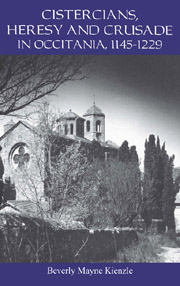Book contents
- Frontmatter
- Contents
- List of Illustrations
- List of Abbreviations
- Chronology
- Preface
- Introduction
- Appendix to Introduction Deconstructing: Close Reading, Rhetorical Criticism, and Historiography of Persecution and Heresy
- 1 The Lord's Vineyard in the Twelfth Century
- 2 Monastic Spirituality and Literature: the Domestic Vineyard
- 3 Bernard of Clairvaux, the 1143/44 Sermons and the 1145 Preaching Mission: From the Domestic to the Lord's Vineyard
- 4 Henry of Clairvaux, the 1178 and 1181 Missions, and the Campaign against the Waldensians: Driving the Foxes from the Vineyard
- 5 Innocent III's Papacy and the Crusade Years, 1198–1229: Weeding the Vineyard
- 6 Hélinand of Froidmont and the Events of 1229: Planting Virtues in the Vineyard
- Conclusion
- Bibliography
- Index
- Title in the series
Appendix to Introduction Deconstructing: Close Reading, Rhetorical Criticism, and Historiography of Persecution and Heresy
Published online by Cambridge University Press: 12 September 2012
- Frontmatter
- Contents
- List of Illustrations
- List of Abbreviations
- Chronology
- Preface
- Introduction
- Appendix to Introduction Deconstructing: Close Reading, Rhetorical Criticism, and Historiography of Persecution and Heresy
- 1 The Lord's Vineyard in the Twelfth Century
- 2 Monastic Spirituality and Literature: the Domestic Vineyard
- 3 Bernard of Clairvaux, the 1143/44 Sermons and the 1145 Preaching Mission: From the Domestic to the Lord's Vineyard
- 4 Henry of Clairvaux, the 1178 and 1181 Missions, and the Campaign against the Waldensians: Driving the Foxes from the Vineyard
- 5 Innocent III's Papacy and the Crusade Years, 1198–1229: Weeding the Vineyard
- 6 Hélinand of Froidmont and the Events of 1229: Planting Virtues in the Vineyard
- Conclusion
- Bibliography
- Index
- Title in the series
Summary
Deconstructing: close reading, rhetorical criticism, and historiography of persecution and heresy
The deconstruction of extant sources requires the discipline of close reading. Trained as a philologist, I retain the conviction that discourse in its written form must be scrutinized carefully in order to discover and uncover whatever historical reality it may contain. Discourse, as Emile Benveniste defined it, encompasses both an oral form and written manifestations which reproduce the oral. This definition suits the analysis of preaching and the sermon quite well, since we are dealing with written vestiges of an oral genre. It also supports the view that the text or speech act is inseparable from the speaker/author, the speaker's intent, and the audience: discourse belongs to a social universe that it reflects. Analysis of discourse entails asking fundamental questions about the text and rests on the close reading, which is often called the explication de texte.
Text and author
To search for the author's voice, the explication de texte provides a starting point: the in-depth analysis of a text directs the reader toward uncovering the writer's point of view, ideas, and intentions, and analysing how these are brought to light and emphasized. The methods of the explication de texte, like those of exegesis, generally employ contextual approaches of literary criticism which examine a passage with attention to its content, historical and literary context, genre, language, development and themes.
- Type
- Chapter
- Information
- Cistercians, Heresy and Crusade in Occitania, 1145–1229Preaching in the Lord's Vineyard, pp. 16 - 24Publisher: Boydell & BrewerPrint publication year: 2001

